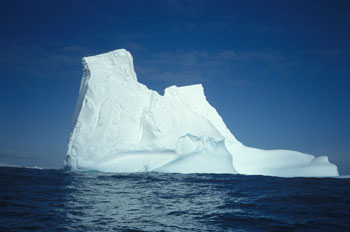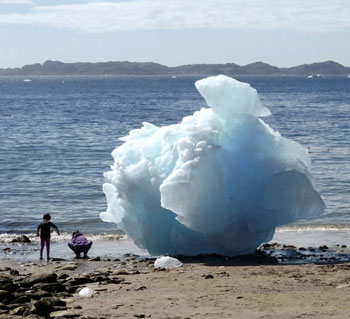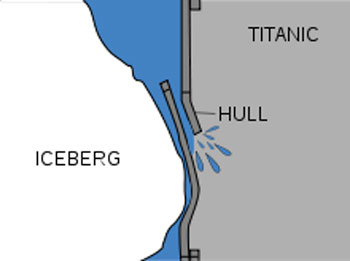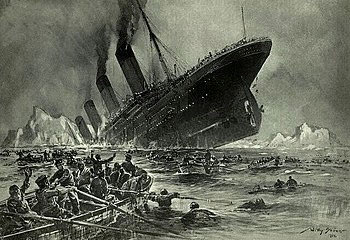The Perils of Iceberg Alley
by Tom Seymour

The ice season runs from February 1 through July 31, during which the U.S. Coast Guard International Ice Patrol actively patrols the area of the Grand Banks of Newfoundland for the extent of iceberg danger.
The year 1856 was a tragedy-laden one for mariners crossing the Atlantic. According to an October, 2018 article by New England Historical Society, more than 830 vessels went missing in the North Atlantic Ocean before the end of March, 1856. It is generally assumed but never proved that in cases lacking survivor testimony, of which there are a great number, the bulk of shipwrecks in that year were caused by collisions with icebergs in a dreaded area of ocean called, “Iceberg Alley.”
Iceberg Alley, or “Ice Alley,” got its name because of a sometimes-steady stream of icebergs entering the sea in the Arctic and floating off the coasts of Newfoundland and Labrador. The number of icebergs floating in Iceberg Alley varies from year-to-year, with some years seeing a steady stream of dangerous “bergs” and other years seeing practically none. Climate, wind and temperature all have a bearing upon the annual number of icebergs afloat in Iceberg Alley.
The most famous victim of Iceberg Alley is known to everyone. The RMS Titanic struck an iceberg on April 14, 1912, when the ship was around 375 miles south of Newfoundland, in the middle of Iceberg Alley. The collision opened five of her 16 watertight compartments, allowing sea water to rush in. Titanic could only withstand four compartments flooding. The great ship was doomed and she sunk during the early morning hours of April 15.
Lacking sufficient lifeboats, many were unable to escape, including the ship’s captain, who went down with his ship. Less than two hours after the sinking, the RMS Carpathian reached the site and managed to save about 705 persons.
The collision opened
five of her 16 watertight compartments.
Included in Titanic’s legacy is the formation of The International Ice Patrol, an agency that monitors and catalogues icebergs in the North Atlantic Ocean. The group tracks not only major icebergs, but also smaller but still hazardous sections of floating ice called, “growlers.” More on this at the end of this article.
Among other well-known shipwrecks in Iceberg Alley during the year 1856 were the SS Pacific and the John Rutledge. The SS Pacific was notable for a number of reasons. The ship was a wooden, sidewheel steamer designed for transatlantic service. The SS Pacific numbered among the fastest and most luxuriously appointed vessels of her time.
During her first year in transatlantic service, Pacific set a new speed record for the transatlantic crossing. Between September 11 and September 21, 1850, the sidewheeler made the passage from Liverpool to New York by averaging 12.46 (14.34 miles per hour) knots per hour. She won the Blue Riband award for the fastest transatlantic crossing.
The Pacific continued her transatlantic crossings without incident, until January 23, 1856, when she departed Liverpool heading for New York. The vessel was never seen again.

Last year, 2017, was, according to the International Ice Patrol, the fourth ‘extreme’ year in a row, with more than 1,000 icebergs crossing 48 North latitude, roughly the middle of Newfoundland.
Her captain at that time was Asa Eldridge of Cape Cod, Massachusetts. Captain Eldridge had earlier been captain of the famous clipper ship Red Jacket and in 1854, set a new transatlantic speed record for the New York to Liverpool crossing by a sailing vessel. But despite having a well-qualified and renowned captain, the vessel never arrived in New York. Fearing the worst, several other vessels were dispatched to search for the Pacific, but no sign of her was found and authorities concluded that the vessel had most likely collided with an iceberg, since bergs were especially prevalent that year.
Then in 1861, an answer to the mystery of the missing vessel came in the form of a note in a bottle recovered on the west side the island of Uist in Scotland’s Hebrides. The short and poignant note went as follows: “On board the Pacific from Liverpool to N.Y. – Ship going down. Confusion on board – icebergs around us on every side. I know I cannot escape. I write the cause of our loss that friends may not live in suspense. The finder will please get it published. W.M. Graham.”
Sinking of the John Rutledge
In January of 1856, the three-masted packet, John Rutledge, sailed from Liverpool headed for New York. The vessel contained, in addition to her captain Alexander Kelley, a crew of around 24 as well as 120 immigrants primarily from Ireland but including people from Scotland and England.
In those days before the transatlantic telegraph, sea captains had only reports from other vessels regarding iceberg presence. And in January, 1856, many captains reported a record number of icebergs in Iceberg Alley. Despite these warnings, Captain Kelley sailed out, as did other vessels, including the afore-mentioned steamship, Pacific.
Then on February 19, the John Rutledge entered a thick fogbank near the Grand Banks, approximately 350 miles southeast of Newfoundland. Unable to detect icebergs because of the fog, the vessel slammed into an iceberg that ripped the ship’s hull open, allowing sea water to enter. In vain, the crew attempted to plug the hole with blankets and rags, but to no avail. The ship was going down.

The force of the iceberg on the Titanic’s steel sheathing snapped the rivets allowing water in.
Unlike the later vessel, Titanic, the John Rutledge, had an open hull, meaning there were no waterproof compartments to seal off in case of a breach of the hull. This helps explain why so many vessels were reported lost and presumed to have struck icebergs in the mid-1800s.
The voyage began on a sinister note when a crew member was carried away by high seas and a passenger was carried through the bulwarks by an immense wave and drowned.
Then on 20, February, 1856, the vessel struck an iceberg and sank. Most of what we know regarding the event comes from testimony by Thomas W. Nye, the only survivor. But even without Captain Nye’s account, the ship’s mate kept a diary describing the events that led up to the collision and fortunately, this diary was found in the lifeboat that carried Thomas Nye. The diary was transcribed and the story ran in the Belmont Chronicle, of Belmont, Ohio, on October 3, 1856:
“February 19, p.m. Follows with light wind and hazy. The vessel was surrounded with icebergs; it being very difficult to steer around them. At 8 saw a large field of ice ahead; tried to steer clear of it but there being little wind it got down to the ship before we could get past it, and the wind dying away we could not steer clear. At 11 the ship was completely wedged with drift-ice and very large icebergs in all directions and the breeze springing right aft, there was no alternative but to proceed through it. The further we got in the thicker the ice got, and the greater the number of icebergs. Midnight, light winds and the ship making very little headway through the ice. 4, morning the same. 8, steady breeze and the ship making more headway. Passed some very large bergs. 9 the I...”
The mate’s report ended with an unfinished sentence and it is widely supposed that around 9 a.m. was the time the vessel struck the fatal iceberg.
The ship had five boats, four of which were launched in succession, with the fifth boat taking a bit longer. This last boat carried the only compass among the group. The mate, Mr. Atkinson, had placed a compass in the boat, but upon leaping in, the mate’s wife struck it and broke it, leaving the occupants with no method by which to fathom direction other than general astronomical signs. Then, during boarding, a huge wave struck the boat, which broke the fastenings that held her to the ship and it drifted off, leaving the mate, the carpenter and from 30 to 35 passengers still onboard the ship, to perish.
As the poor stricken souls
died, they lost their minds,
screaming and lashing out.
After the sinking, the ship’s boats separated and none except one was ever seen again. This boat carried, among its 13 passengers, one Thomas Nye of New Bedford, Massachusetts. Nye’s account details what occurred next.
According to Nye, Mrs. Atkinson entered the boat and immediately seized the only container of water, which the other passengers attempted to wrest from her. But, said Nye, “She, being a robust woman, fought off all who attempted to obtain a drink from it.” The boat carried a portion of bread, but Nye makes no mention of it. It is thought that, aided by Mrs. Atkinson’s behavior, that confusion ran rampant and that someone or several people also ate the bulk of the bread.
Help was some time in coming. Meanwhile, with food and water gone, thirst set in and soon, some of the passengers began drinking seawater. The expected consequences of this act claimed many lives. One by one the passengers grew faint, weak, dying where they lay. However, Thomas Nye did not consume seawater, despite a burning thirst and that was what saved his life.
At one point the boat sighted a passing brig and despite signaling with an upraised oar and pulling as fast and as hard as their physical conditions permitted, was unable to gain the brig’s attention. This great disappointment must have had a chilling effect on the passengers and soon, this effect took its toll. As one after the other of the boat’s passengers died, only one remained; Thomas Nye. As the poor stricken souls died, they lost their minds, screaming and lashing out. One, in his death throes, struck Nye in the face.

The Titanic going down April 15, 1912 in Iceberg Alley off Newfoundland while on its maiden voyage from Liverpool, England to New York.
By this time, Nye was so weakened that he could not slide the remaining four dead bodies over the side. But he was able to tie a red handkerchief to an oar and to affix the oar in an upright position to the boat, making a stationary distress signal.
Eventually, Nye’s feet and legs were frozen and he began dozing off from time to time, only to awaken and summon all his energy to bail water from the boat. Then on February 28, after nine agonizing days in the boat, Nye sighted a vessel. It was the Germania, and she hove-to and sent out a boat for his relief.
Nye later wrote, “My frozen limbs were put in cold water, and then bran poultices were applied to them. To this, and other judicious treatment which I received at the hands of my good friends on board the Germania, I shall be indebted for the restoration of my limbs to use. I belong in Bedford, Mass. I have never supposed my constitution was especially rugged. I weighed about 146 pounds when I left New York. I attribute the continuance of my existence beyond that of my companions to my abstaining from the use of seawater. I used some of the ice that formed upon the boat It was only a little bitter, having lost the brackish, taste peculiar to sea water, and was without its injurious effect upon my system.”
The story of the shipwreck of the John Rutledge, so filled with drama and pathos, has carved out for itself a place in the history of shipwrecks. And while it might come as scant comfort to those who went down with iceberg-stricken vessels in the past, modern mariners have the means to detect icebergs well in advance of any chance of collision.
Ice Patrol
My frozen limbs were
put in cold water.
The International Ice Patrol (IIP) has as its stated purpose, to promote safe navigation of the Northwest Atlantic Ocean when the danger of iceberg collision exists. According to the IIP, “The ice season runs from February 1 through July 31, during which the U.S. Coast Guard International Ice Patrol actively patrols the area of the Grand Banks of Newfoundland for the extent of iceberg danger.”
The IIP uses fixed wing aircraft for reconnaissance work. Flights operate on the average of five days per week throughout the ice season. Data gained from reconnaissance is fed into a computer model at IIP Operations Center, along with current and wind data. Using these data, the model predicts the drift of icebergs.
The IIP predicts that the current year will carry dangers similar to recent years. Warming in the Arctic has caused a significant increase of “calving,” or ice shearing off from the Greenland ice sheet and entering the sea. Last year, 2017, was, according to the IIP, the fourth ‘extreme’ year in a row, with more than 1,000 icebergs crossing 48 North latitude, roughly the middle of Newfoundland, posing a particularly hazardous situation for transatlantic shipping.
But unlike the year 1856, modern mariners have detailed, up-to-date information to help circumvent collisions with icebergs. And that is very good news.
